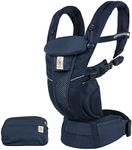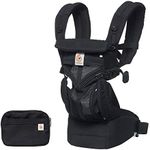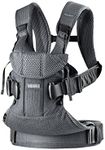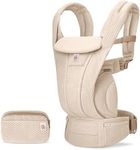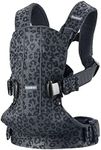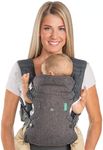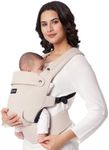Buying Guide for the Best Baby Carriers
Choosing the right baby carrier can make a significant difference in your comfort and your baby's safety and happiness. Baby carriers come in various styles and designs, each with its own set of features. When selecting a baby carrier, it's essential to consider factors such as comfort, safety, ease of use, and the age and weight of your baby. Understanding the key specifications will help you make an informed decision that best suits your needs and lifestyle.Type of CarrierThere are several types of baby carriers, including wraps, slings, soft-structured carriers, and backpack carriers. Wraps are long pieces of fabric that you tie around yourself and your baby, offering a customizable fit. Slings are worn over one shoulder and are great for quick and easy use. Soft-structured carriers have padded straps and buckles for added support and are suitable for longer wear. Backpack carriers are ideal for older babies and toddlers, especially for outdoor activities. Your choice should depend on how you plan to use the carrier and your comfort with each style.
Weight and Age RangeEach baby carrier has a recommended weight and age range. This specification is crucial for ensuring your baby's safety and comfort. Newborns typically require carriers that offer head and neck support, while older babies and toddlers need carriers that can support their growing weight. Check the manufacturer's guidelines to ensure the carrier is appropriate for your baby's current weight and age.
ComfortComfort is essential for both you and your baby. Look for carriers with padded shoulder straps and waist belts to distribute your baby's weight evenly and reduce strain on your back and shoulders. Adjustable straps and ergonomic designs can also enhance comfort. For your baby, ensure the carrier provides proper support for their hips, spine, and neck. Trying on different carriers can help you find the most comfortable option.
Ease of UseEase of use refers to how simple it is to put on, adjust, and take off the carrier. Some carriers have multiple buckles and straps, which can be more secure but also more complicated to use. Others, like wraps and slings, may require a bit of practice to master. Consider how often you'll be using the carrier and whether you'll need to put it on quickly and easily, especially if you're often on the go.
BreathabilityBreathability is important to keep both you and your baby comfortable, especially in warmer weather. Carriers made from lightweight, breathable fabrics like cotton or mesh can help prevent overheating. If you live in a hot climate or plan to use the carrier during the summer, look for materials that promote airflow and wick away moisture.
Safety FeaturesSafety features are crucial in a baby carrier. Look for carriers that meet safety standards and have secure buckles, straps, and fastenings. The carrier should provide proper support for your baby's head, neck, and spine. Additionally, ensure that the carrier allows for healthy hip positioning to prevent hip dysplasia. Always follow the manufacturer's instructions for safe use.
VersatilityVersatility refers to the different carrying positions a carrier offers. Some carriers allow for multiple positions, such as front-facing, back-carry, and hip-carry. This can be beneficial as your baby grows and their needs change. A versatile carrier can provide more value and adapt to different situations, such as breastfeeding or napping on the go.
DurabilityDurability is important to ensure the carrier lasts through your baby's early years and possibly for future siblings. Look for carriers made from high-quality materials that can withstand regular use and washing. Reinforced stitching and sturdy buckles can also contribute to the carrier's longevity. Reading reviews and checking the warranty can give you an idea of the carrier's durability.
